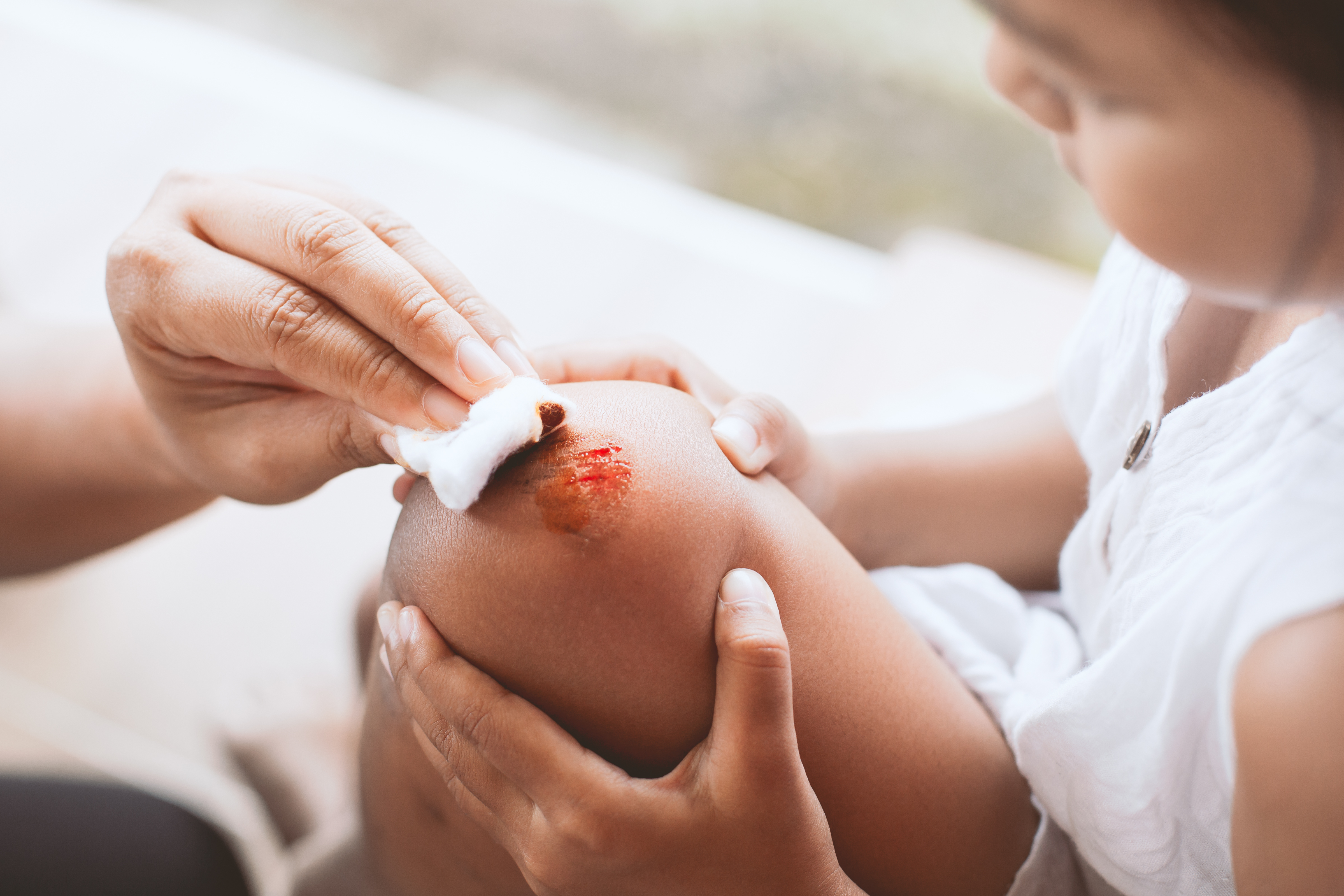How to Clean a Wound
Cuts and grazes are part and parcel of life. Knowing how to properly clean and treat basic minor wounds will help prevent a graze or wound becoming infected and aid in proper healing.
- Cleaning Cuts
- Cleaning Grazes
- Reducing the risk of infection
- When should I see a doctor?
- How do you clean a wound?
- Tips for wound healing
Cleaning Cuts
A cut is essentially a tear to the skin. A cut can be described as a laceration, which is caused by a blunt force like a fall, or an incised wound, which is caused by a sharp object like a knife or piece of glass slicing into the skin. A bite injury can also be considered a type of cut.
For minor cuts, the first thing you may need to do is stop the bleeding. Remove any clothing that’s in the way, then apply firm but gentle pressure with a clean cloth, gauze or bandage. If it’s possible, try to raise the cut above heart level.
Once the bleeding has stopped, clean the wound to help remove any germs and foreign objects. Start by flushing it out with warm, clean tap water or an antiseptic liquid. You can use soap and a soft washcloth to clean the skin around the cut but try to keep the soap out of the wound itself.
After cleaning the cut, cover it with a clean dressing. This will help to keep the wound clean and protect the area as it heals. Keeping the wound covered also keeps the wound moist, which can aid healing.
If your cut is deep or if you can’t stop the bleeding, apply appropriate first aid and seek medical attention immediately. You may need to have the wound closed with stitches, glue or staples.
Cleaning Grazes
A skin graze or abrasion is when the surface layers of the skin have been scraped and broken, usually by friction against a rough surface. Thin-skinned bony areas like the knees and elbows are more prone to grazes.
Just like a cut, cleaning the graze is important to remove any dirt and other foreign objects. Use clean water and a piece of sterile gauze (or other non-shedding cloth) to gently wipe the graze – don’t scrub at embedded dirt as this can traumatise the wound more. After 5 minutes, rinse the graze with flowing tap water, then cover with an appropriate non-stick sterile dressing.
For grazes where deep layers of skin have been removed, apply appropriate first aid and seek urgent medical attention.
Reducing the risk of infection
Our skin provides a natural barrier to germs. When we get a wound, that barrier is broken, and harmful bacteria are able to enter and may cause infection. Bacteria can be introduced by whatever it is that punctured the skin, or even by the movement of bacteria that otherwise live harmlessly on our skin.
An infection disrupts the healing process and can make you very sick. Signs of an infected wound include:
- Worsening pain
- Redness or swelling
- Warm skin around the wound
- A bad odour coming from the wound, even after it’s been cleaned
- A change in the colour or amount of discharge from the wound
- Fever, chills, nausea or vomiting
- If you are experiencing or noticing any of the above signs, see your doctor immediately.
To help reduce the risk of an infected wound, you can:
- Wash your hands before managing the wound. If it’s practical, you can also put on disposable gloves.
- Avoid breathing or coughing into the wound.
- Cover the wound with a sterile dressing, trying not to touch the dressing’s surface before applying it to the wound.

When should I see a doctor?
Aside from when you are experiencing signs of infection like those mentioned above, you should also see a doctor if:
- you can’t properly clean dirt and debris out of the cut
- you have cut your hand from punching something or the cut is over a joint
- the wound is more than a few millimetres deep
- the sides of the cut don’t sit together well by themselves (so it remains wide open)
- the wound is in, or near, your eye
- the wound is from a bite, whether by an animal or another human
- you got the cut or abrasion while in dirty water
How do you clean a wound?
Using Dettol Antiseptic Liquid to clean cuts or scratches can help protect the wound from infection. Make sure to dilute the Dettol first by mixing 20ml with 400ml of water. This diluted mixture can then be used to cleanse the wound.
For a more convenient option, Dettol Antiseptic Wound Wash Spray comes ready to use, and the spray format also means you can avoid touching the wound. Simply spray to wash away any dirt or debris, then wipe up any excess liquid with cotton wool or tissue.
A few important things to remember when using Dettol:
- Don’t use Dettol Antiseptic Liquid or Dettol Wound Wash Spray on babies under 12 months old
- Don’t mix them with other detergents or chemicals
- Make sure to discard any diluted Dettol Antiseptic Liquid that you don’t use
- Only use Dettol Wound Wash Spray once every 24 hours, and for no longer than 5 consecutive days
Tips for wound healing
When you get a wound, your body will start to repair itself immediately. First, the body will form a blood clot at the injury site and send white blood cells to start cleaning it of bacteria and other foreign objects. Then, new layers of skin will start to grow around the wound, encouraging the edges of the wound to contract and close. Over time, more and more new skin cells will be added to cover the wound.
There are a few things you can do to help your body along with this process:
- Keep your wound dressed, as this helps to keep it warm which can help the wound heal faster. Be quick when changing your dressing to avoid too much exposure to open air, which could drop the wound’s temperature.
- Eat well to fuel the healing process, including foods rich in vitamin C which is needed to make new skin cells. Eating fresh fruit and veg daily will also supply the body with essential wound-healing nutrients like vitamin A, copper and zinc.
- Exercising can increase blood flow, improve general health and also speed wound healing. Ask your doctor about appropriate exercises so you don’t strain your wound.
Whatever the minor mishap, the important thing to remember is to properly clean and dress any cuts or grazes. By including Dettol in your first aid routine, you can help protect against infection.
Always read the label. Follow the directions for use. If symptoms persist, talk to your health professional.
First published:
Last updated:
